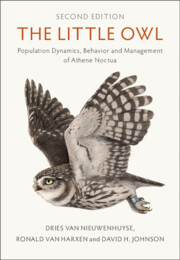Book contents
- The Little Owl
- The Little Owl
- Copyright page
- Contents
- Foreword
- Preface
- Acknowledgements
- Executive Summary
- Chapter 1 Introduction: Framework
- Chapter 2 History and Traditions
- Chapter 3 Fossil Evidence, Taxonomy and Genetics
- Chapter 4 Morphology and Body Characteristics
- Chapter 5 Distribution, Population Estimates and Trends
- Chapter 6 Habitat
- Chapter 7 Diet
- Chapter 8 Breeding Season
- Chapter 9 Behavior
- Chapter 10 Population Regulation
- Chapter 11 Management and Conservation
- Chapter 12 Research Priorities
- References
- Index
Chapter 4 - Morphology and Body Characteristics
Published online by Cambridge University Press: 29 September 2023
- The Little Owl
- The Little Owl
- Copyright page
- Contents
- Foreword
- Preface
- Acknowledgements
- Executive Summary
- Chapter 1 Introduction: Framework
- Chapter 2 History and Traditions
- Chapter 3 Fossil Evidence, Taxonomy and Genetics
- Chapter 4 Morphology and Body Characteristics
- Chapter 5 Distribution, Population Estimates and Trends
- Chapter 6 Habitat
- Chapter 7 Diet
- Chapter 8 Breeding Season
- Chapter 9 Behavior
- Chapter 10 Population Regulation
- Chapter 11 Management and Conservation
- Chapter 12 Research Priorities
- References
- Index
Summary
This chapter gives an overview of the embryonic development and morphological characteristics of the Little Owl. We first look at how the egg develops, with special attention paid to the temporary asymmetric ears, then zoom in on owlet development as they grow and the plumage of adult birds and how molt takes place. The eyes are special and the species has retinal cells similar to diurnal birds of prey. While Little Owls can differentiate several colors, the species does not see infra-red rays. It has an auditory sensitivity to locate small rodents with an accuracy of up to 1%. The bill is yellowish and its color functions as a signal for the fitness of both juveniles and adults. The Little Owl has differential biometrical measures (such as length of wing, tail, tarsus) according to the subspecies or according to the sex (such as weight - females are heavier close to the breeding time). We finally examine the voice. The species has a large vocal repertoire, including 40 acoustic signals and combinations with regional specificities. The chapter concludes with specific characteristics for flight and the anatomy.
- Type
- Chapter
- Information
- The Little OwlPopulation Dynamics, Behavior and Management of <I>Athene noctua</I>, pp. 89 - 145Publisher: Cambridge University PressPrint publication year: 2023

